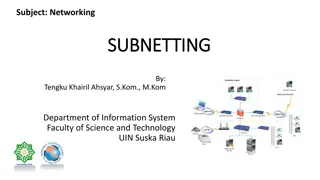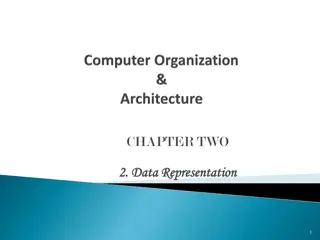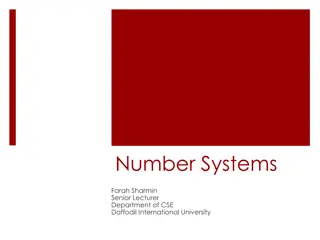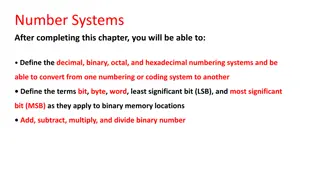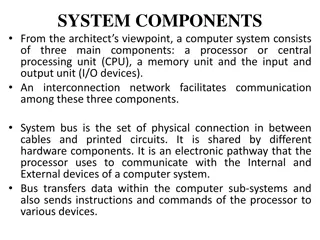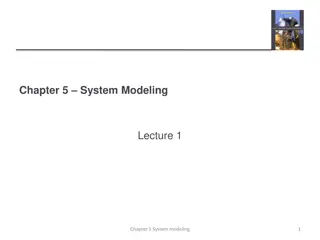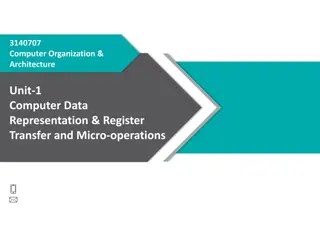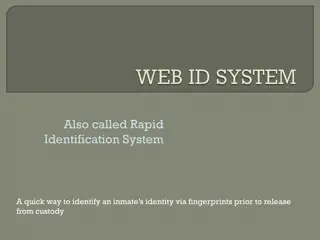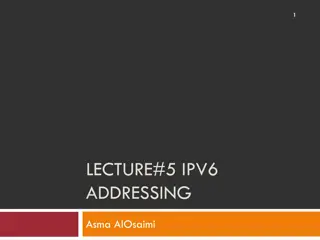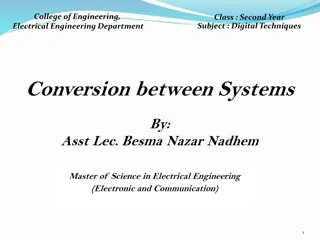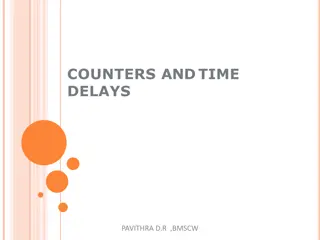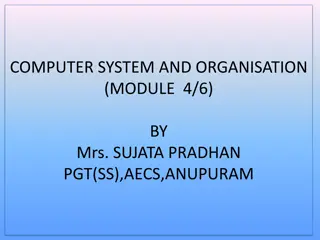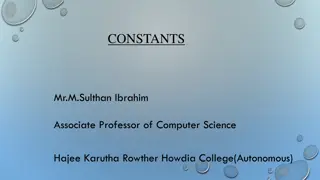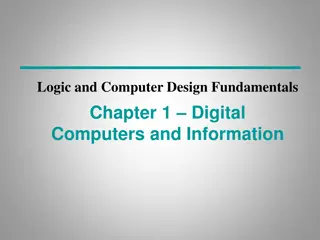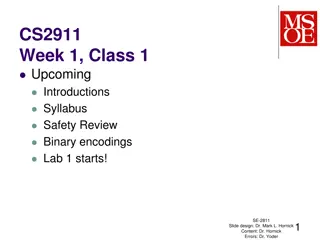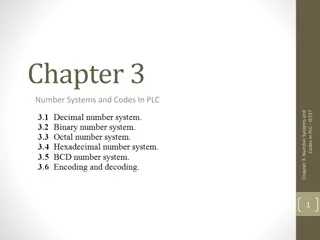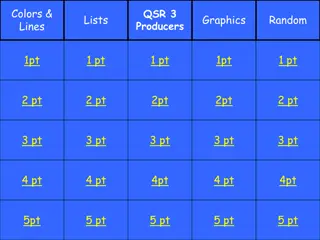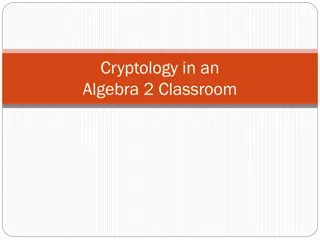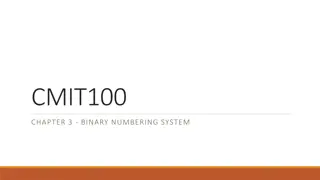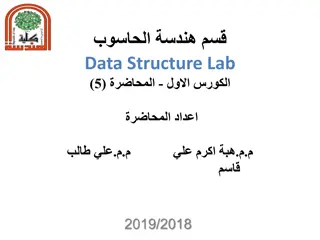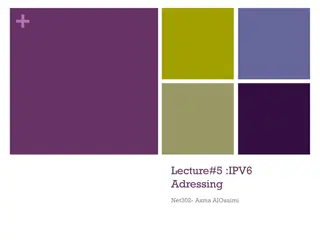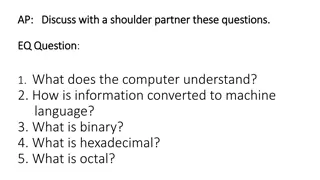Bentham and Hooker's System of Classification in Botany
Bentham and Hooker's system of classification in botany is a natural system based on a large number of characters considered simultaneously. Proposed by British taxonomists George Bentham and Joseph Dalton Hooker, this system categorizes seed plants into classes, orders, families, and genera. It is
2 views • 10 slides
adonai software
Adonai college Management System is a cloud-based ERP System that delivers various College and School Management Systems, College and School Management Software, College and School Management System ERP, College and School Management Software System, Online College and School Management Software Sys
3 views • 1 slides
System Models in Software Engineering: A Comprehensive Overview
System models play a crucial role in software engineering, aiding in understanding system functionality and communicating with customers. They include context models, behavioural models, data models, object models, and more, each offering unique perspectives on the system. Different types of system
2 views • 33 slides
Understanding the Nervous System: CNS, PNS, SNS, and ANS
The nervous system comprises the Central Nervous System (CNS) and Peripheral Nervous System (PNS), with the PNS further divided into the Somatic Nervous System (SNS) and Autonomic Nervous System (ANS). The SNS controls voluntary movements of skeletal muscles, while the ANS regulates involuntary proc
2 views • 23 slides
Mastering Subnetting: A Comprehensive Overview
Delve into the world of subnetting with Tengku Khairil Ahsyar's course outline covering IP address conversion, subnet mask calculation, and more. Learn about binary, octal, decimal, and hexadecimal number systems along with conversion techniques. Understand the significance of subnetting for efficie
1 views • 25 slides
Understanding Binary Number System and its Applications
Explore the world of binary numbers with insights on what binary is, its significance in computing, conversion methods between binary and decimal, hexadecimal number system, and binary arithmetic operations. Dive into the foundations of digital communication through the language of zeros and ones.
0 views • 24 slides
GDS System
Travelopro Global Distribution System (GDS) is a computerized network system. It is a large computer network which is integrated with 100 of worldwide Airlines and consolidators for enabling transactions between travel agents and travel sites and also used by airlines, hotels, car rentals, railways
4 views • 15 slides
Understanding the Immune System: Organs, Functions, and Importance
The immune system acts as a defense mechanism against pathogens and infections, comprising various organs, such as the bone marrow, thymus, spleen, white blood cells, antibodies, complement system, and the lymphatic system. It works to recognize and destroy harmful microbes, maintaining the body's h
1 views • 23 slides
Understanding Number Systems in Computer Science
Exploring how modern computer systems represent numeric values using various numbering systems such as binary, decimal, and hexadecimal. Discover the fundamentals of each system, their importance in digital systems, and methods for representing negative integers.
0 views • 17 slides
Evolution of Land Law Systems in Trinidad and Tobago
Trinidad and Tobago's land law systems consist of the Common Law System and the Registered Land System. The Common Law system governs unregistered land where title passes upon execution and delivery of the deed. In contrast, the Registered Land System confers ownership upon registration and offers c
0 views • 28 slides
Understanding Number Systems and Their Characteristics
Dive into the world of number systems, exploring non-positional and positional systems. Learn about the unique features of each system, including the use of symbols and digits, as well as how to convert numbers between different bases. Discover the Decimal Number System and its significance in every
2 views • 33 slides
Understanding Number Systems in Digital Computing
Explore the decimal, binary, octal, and hexadecimal numbering systems essential for digital computing. Learn to convert between these systems, grasp terms like bit, byte, and word, and perform basic binary arithmetic operations. Visual aids and explanations make complex concepts easily understandabl
0 views • 24 slides
Understanding Computer System Buses: Components and Functions
A computer system comprises three main components - the CPU, memory unit, and I/O devices connected via an interconnection network, facilitated by the system bus. System buses reduce communication pathways, enabling high-speed data transfer and synchronization between components. Internal buses conn
3 views • 55 slides
Understanding System Modeling in Engineering
System modeling in engineering involves developing abstract models to represent a system from various perspectives using graphical notations like UML. These models aid in understanding system functionality, communicating with stakeholders, and documenting requirements for new systems. Existing and p
2 views • 53 slides
Comprehensive Overview of Computer Data Representation and Operations
Delve into the intricate world of computer data representation and micro-operations, covering topics such as binary, octal, and hexadecimal number systems, complements, fixed-point and floating-point representations, arithmetic and logic micro-operations, register transfer language, and more.
1 views • 70 slides
Rapid Identification System for Inmate Release
The Rapid Identification System, also called Rapid ID System, provides a quick way to verify an inmate's identity using fingerprints before release from custody. It allows law enforcement agencies, including IPD users under SDSheriff, to log in and access the system. By searching the San Diego AFIS
3 views • 8 slides
Understanding System Management Mode (SMM) in x86 Processors
System Management Mode (SMM) is a highly privileged mode in x86 processors that provides an isolated environment for critical system operations like power management and hardware control. When the processor enters SMM, it suspends all other tasks and runs proprietary OEM code. Protecting SMM is cruc
1 views • 26 slides
Understanding 7-Segment Displays for Beginners
Appreciate the use of 7-segment displays, which consist of 7 LEDs and a separate LED for the decimal point. Learn about common cathode and common anode displays, connections, displaying numbers, and showcasing hexadecimal values on these displays. Gain insights on how to illuminate specific segments
0 views • 13 slides
Advanced Techniques for Multiplication Performance Improvement
Explore advanced methods to enhance multiplication performance by utilizing shifts and add/subtract operations instead of traditional arithmetic. The solutions provided involve hexadecimal number pairs, demonstrating the best ways to calculate products efficiently. Furthermore, a challenge is presen
2 views • 59 slides
Understanding IPv6 Addressing and Migration Techniques
IPv6 is designed as the successor to IPv4 due to the depletion of IPv4 address space. This lecture covers topics such as the need for IPv6, IPv4 and IPv6 coexistence techniques like dual-stack, tunneling, and translation, IPv6 addressing using the hexadecimal number system, and IPv6 address represen
0 views • 30 slides
Digital Techniques for Number System Conversion in Electrical Engineering
Understand how to convert between binary, octal, decimal, and hexadecimal number systems with examples and explanations. Learn the processes of binary-to-decimal, octal-to-decimal, hexadecimal-to-decimal, decimal-to-binary, decimal-to-octal, and decimal-to-hexadecimal conversions. Gain insights into
0 views • 10 slides
Understanding Counters and Time Delays in Electronics
Explore the fundamental concepts of counters and time delays in electronic systems as explained by Pavithra D.R. from BMSCW. Learn about the design and operation of counters, time delay procedures, label states, time delay using register pairs, flowcharts for time delays, and illustrative programmin
5 views • 10 slides
System Sequence Diagrams: Understanding Artifact for System Behavior
System Sequence Diagrams (SSDs) are vital artifacts that visually illustrate input and output events related to a system. They help define system behavior and interactions, making them essential during the logical design phase of software applications. By depicting events in sequential order, SSDs o
2 views • 24 slides
Understanding Number Systems and Conversions in Computer Systems
Explore the fundamentals of number systems in computer science, including decimal, binary, octal, and hexadecimal. Learn conversion methods between different bases and practical examples like converting decimal to binary. Dive into octal-binary conversions with solved problems. Enhance your knowledg
1 views • 16 slides
Understanding Different Types of Constants in Programming
Constants in programming are fixed values that do not change during program execution. They include character, numerical, and string constants. Integer constants can be decimal, octal, or hexadecimal. This article explains each type of constant with examples of decimal, octal, and hexadecimal intege
0 views • 22 slides
Understanding Hexadecimal Numbering System
Hexadecimal numbering system provides a compact and efficient way to represent numbers, especially in computing. It uses digits 0-9 and letters A-F to represent values from 0 to 15. Converting between decimal and hexadecimal is crucial in computing, and hexadecimal numbers are widely used in binary
0 views • 88 slides
Comprehensive Overview of Anti-Passback Control System
The Anti-Passback Control System is designed to prevent misuse of cards, track and restrict the number of people in an area, and trigger system events based on occupancy levels. It includes features such as interlocking of reader use, enforcement options, and event triggers for controlling system op
0 views • 18 slides
Digital Computers and Information Representation Fundamentals
Explore the basics of digital systems, number systems, arithmetic operations, and information representation in computers. Dive into binary, octal, and hexadecimal systems, along with signal processing and number system examples. Gain insights into computer organization and assembly language, utiliz
0 views • 28 slides
Understanding Ions and Their Importance in Your Body
Neutral atoms have the same number of protons and electrons, with the charge of the nucleus always positive. The mass number is the sum of protons and neutrons. The number of neutrons can be calculated by subtracting the atomic number from the mass number. Ions are atoms with a positive or negative
0 views • 15 slides
Understanding Binary Encodings and Internet Communication
Learn about binary encodings, sending data over the internet, bytes, hexadecimal representation, and character encoding in this informative content. Dive into the basics of representing information digitally and discover how to communicate effectively in the digital world.
0 views • 33 slides
Understanding Number Systems and Codes in PLC
Delve into the world of number systems and codes in Programmable Logic Controllers (PLC) with a focus on decimal, binary, octal, and hexadecimal systems. Learn how data is represented and manipulated in PLC applications through various numeric systems and codes. Explore the significance of bits, byt
0 views • 12 slides
Learning Colors, Lines, and Hex Codes for Design
Explore the world of colors, lines, producers, lists, graphics, and hexadecimal codes in this informative image-based content. Learn about hex codes, HTML tags for changing background and text colors, creating lists, and more. Test your knowledge with interactive examples and visuals that demonstrat
0 views • 51 slides
Introduction to Cryptology in Algebra 2 Classroom
Engage students in a high school Algebra 2 class by exploring cryptology concepts such as coding, hexadecimal systems, substitution ciphers, and the Vigenere cipher. The lesson plan includes activities like solving puzzles, introducing binary systems, converting to hexadecimal, and writing messages
0 views • 16 slides
Understanding Binary Numbering Systems and Character Representation in Computing
Explore the world of numbering systems including decimal, binary, octal, and hexadecimal, and delve into how characters are stored in computer memory. Learn about Boolean operations and their application on binary numbers, with a focus on IP addresses. Discover the importance of ASCII, Unicode, and
0 views • 26 slides
Understanding Binary Operations and Bitwise Manipulations in Programming
Exploring topics such as integers, bits, bytes, bitwise operators, signed vs. unsigned numbers, binary-hexadecimal conversion, and practical exercises to grasp essential concepts in computer programming.
0 views • 73 slides
Understanding Constants and Literals in C++ Programming
Constants and literals in C++ are fixed values that the program cannot alter. They come in various types such as integer numerals, floating-point numerals, characters, strings, and boolean values. Integer literals can be decimal, octal, or hexadecimal constants, while floating-point literals have in
0 views • 7 slides
Understanding Data Handling in Python
Types of data in Python include Number, String, List, Tuple, Set, and Dictionary. Python supports integers, floating point numbers, and complex numbers with the classes int, float, and complex. Different number systems like binary, hexadecimal, and octal are also supported. Type conversion in Python
0 views • 49 slides
IPv6 Addressing and Coexistence: Overview and Challenges
This lecture covers essential topics on IPv6 addressing, including IPv4 issues, the need for IPv6, address representation, types, testing, and verification. It explains how IPv6 is designed to overcome the limitations of IPv4, particularly the depletion of the IPv4 address space. The discussion also
0 views • 44 slides
Strategies for Enhancing Extended Producer Responsibility System in Bulgaria
Korea-Bulgaria Knowledge Sharing Program focused on sharing strategies to enhance Bulgaria's Extended Producer Responsibility (EPR) system. The program discusses the current status, performance evaluation, issues, and recommendations related to the EPR system in Korea. It covers topics like beverage
0 views • 38 slides
Understanding Binary Numbers and Computer Data Representation
A computer stores information digitally as binary numbers, where data is broken down into pieces and represented as numbers. The binary system uses 0s and 1s to encode information, with each bit representing on/off states. This system is crucial for converting data into machine language. Binary numb
0 views • 14 slides




